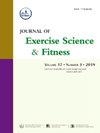The effects of different work: Rest durations on physiological, neuromuscular, and ratings of perceived exertion responses during taekwondo-specific high-intensity interval training
IF 2.4
2区 医学
Q2 SPORT SCIENCES
引用次数: 0
Abstract
Purpose
To investigate the effect of different work: rest durations on physiological, neuromuscular, and perceived exertion responses during taekwondo-specific high-intensity interval training (HIIT).
Methods
Thirteen moderate-trained taekwondo athletes (age: 21.7 ± 2.4 years; body mass: 69.1 ± 7.6kg; height: 174 ± 6 cm) completed a familiarization session and three HIIT trials. The trial consisted of three rounds of 2 min roundhouse kicks with 1 min of rest in between. In each round, the work: rest ratio was constant at 1:2, and the work: rest duration varied to be: short (2s:4s), medium (10s:20s), and long (20s:40s). Heart rate (HR) and oxygen uptake ( O2) were continuously measured. Blood lactate concentration ([La−]), countermovement jump (CMJ), and rating of perceived exertion (RPE) were recorded before trials and after each round. Energy contribution was estimated.
Results
HR, O2, and CMJ were similar across protocols (P > .05) but, [La−] was higher during long than short work: rest duration protocol (P < .05). Relative aerobic energy contribution and RPE in round 3 were higher during long than short work: rest duration protocol (P < .05). Absolute and relative glycolytic energy contribution in rounds 1 and 2 were higher during long than short work: rest duration protocol (P < .05). Relative phosphate energy contribution in rounds 1 and 3 was lower during long than short work: rest duration protocol (P < .05).
Conclusion
Different work: rest durations of taekwondo-specific HIIT influenced [La−], energy system contributions, and RPE. The longer work: rest duration protocol (20s:40s) stressed more the glycolytic, aerobic energy systems and perceived exertion, and less the phosphagen energy system.
不同的工作:休息时间对生理,神经肌肉的影响,以及在跆拳道特定的高强度间歇训练中感知运动反应的评级
目的探讨跆拳道高强度间歇训练(HIIT)中不同作息时间对生理、神经肌肉和知觉运动反应的影响。方法中等训练跆拳道运动员13例(年龄:21.7±2.4岁;体重:69.1±7.6kg;身高:174±6厘米)完成了熟悉期和三次HIIT试验。试验包括三轮,每轮2分钟的回旋踢,中间休息1分钟。在每一轮中,工作与休息的比例不变为1:2,工作休息时间分为短(2s:4s)、中(10s:20s)和长(20s:40s)。连续测量心率(HR)和摄氧量(V˙O2)。在试验前和每轮试验后记录血乳酸浓度([La−])、反运动跳跃(CMJ)和感知运动评分(RPE)。对能源贡献进行了估计。结果不同治疗方案的shr、V˙O2和CMJ相似(P >;.05),但长作息时间方案[La−]高于短作息时间方案(P <;. 05)。第3轮的相对有氧能量贡献和RPE在长时间工作和休息方案中高于短时间工作和休息方案(P <;. 05)。第1轮和第2轮的绝对和相对糖酵解能量贡献在长时间工作和休息时间方案中高于短时间工作和休息时间方案(P <;. 05)。第1轮和第3轮的相对磷酸盐能量贡献在长时间工作和休息时间方案中低于短时间工作和休息时间方案(P <;. 05)。结论跆拳道特异性HIIT的不同工作休息时间影响[La−]、能量系统贡献和RPE。较长的工作:休息时间方案(20s:40s)更多地强调糖酵解、有氧能量系统和感知运动,而较少强调磷能量系统。
本文章由计算机程序翻译,如有差异,请以英文原文为准。
求助全文
约1分钟内获得全文
求助全文
来源期刊
CiteScore
5.10
自引率
3.60%
发文量
54
审稿时长
31 days
期刊介绍:
The Journal of Exercise Science and Fitness is the official peer-reviewed journal of The Society of Chinese Scholars on Exercise Physiology and Fitness (SCSEPF), the Physical Fitness Association of Hong Kong, China (HKPFA), and the Hong Kong Association of Sports Medicine and Sports Science (HKASMSS). It is published twice a year, in June and December, by Elsevier.
The Journal accepts original investigations, comprehensive reviews, case studies and short communications on current topics in exercise science, physical fitness and physical education.

 求助内容:
求助内容: 应助结果提醒方式:
应助结果提醒方式:


